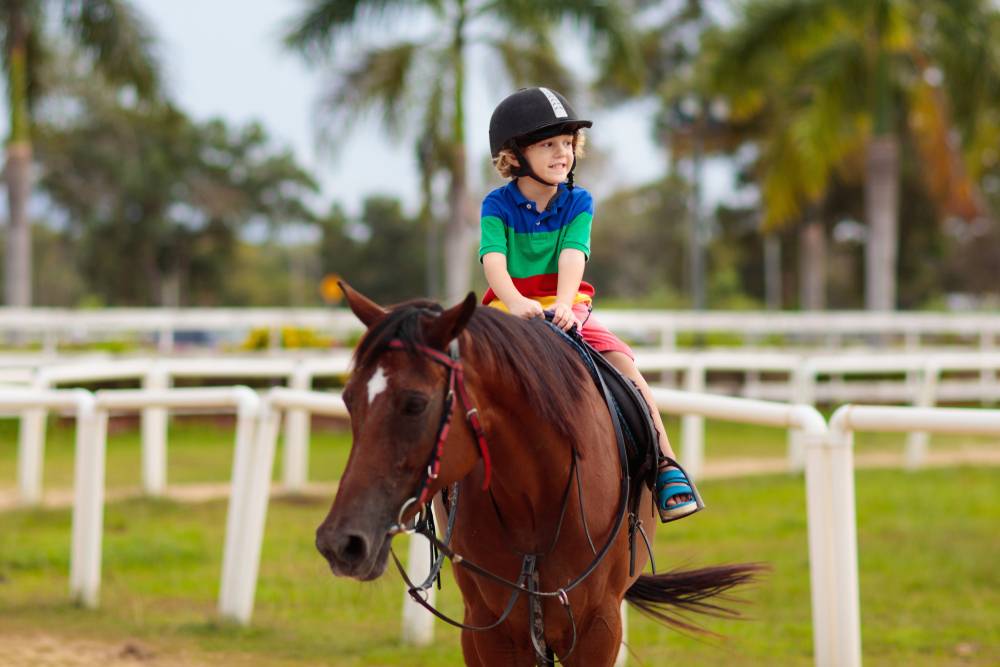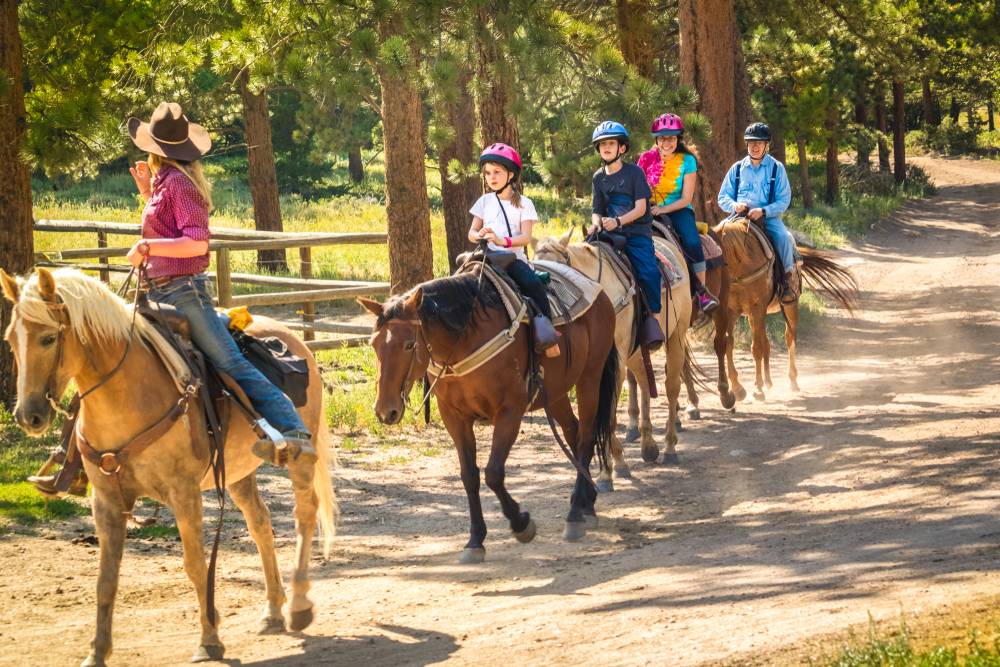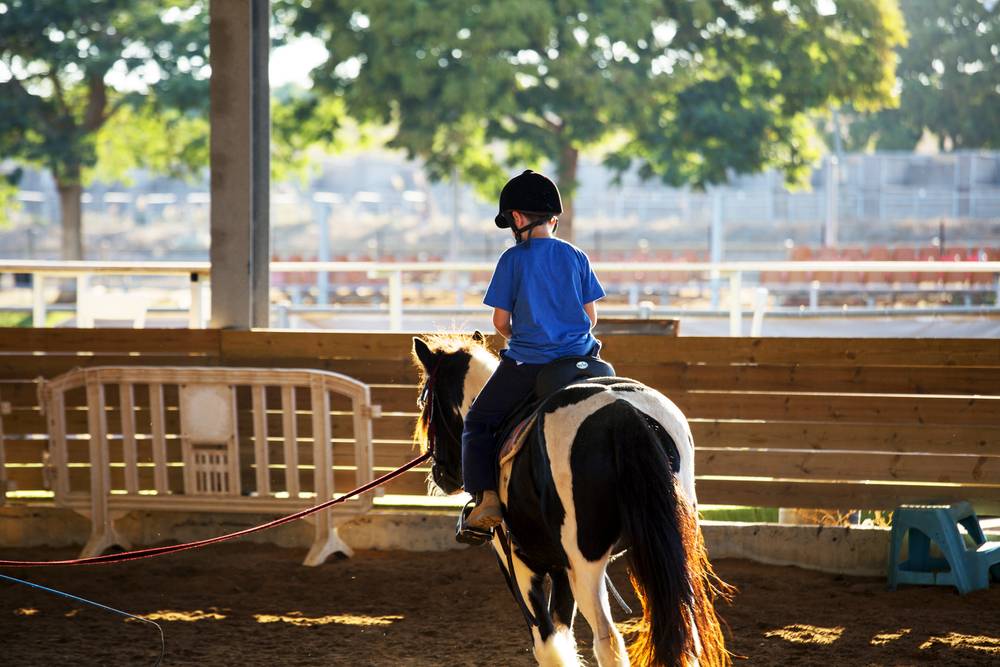
Horseback riding provides a distinctive combination of physical exercise, mental stimulation, and emotional development for children. While the appeal of this equestrian activity is undeniable, it is vital for parents to comprehend the potential hazards and implement essential safety measures. Let’s explore the advantages of horseback riding for kids, examine the possible dangers, and offer thorough safety recommendations.
So, Is Horseback Riding Dangerous for Children?
Horse riding may pose risks for children, including falls and unpredictable horse behavior. However, with proper safety measures like quality gear, professional instruction, and understanding horse behavior, these risks can be significantly minimized. Thus, kids should be careful around horses to safely enjoy the numerous benefits of the activity.
The Common Benefits of Horseback Riding for Children
Physical Benefits
Horse riding offers more than just the picturesque sight of children riding horses; it also offers notable physical advantages. Riding necessitates balance, coordination, and core strength. As kids strive to maintain their posture and equilibrium while controlling the horse’s movements, their muscles naturally strengthen. This consistent engagement of muscle groups aids in the improvement of motor skills and overall physical fitness.
Mental and Emotional Benefits
The connection between a child and their equine has the potential to cultivate crucial life skills. Engaging in horseback riding enhances self-confidence and self-esteem as children acquire the ability to communicate with and guide a majestic animal. This newfound sense of mastery over a powerful creature fosters a positive self-perception. The responsibility of tending to a horse nurtures empathy and compassion, imparting to children the significance of caretaking for others.

Recognizing the Potential Risks
Engaging in any physical activity carries inherent risks, and riding a horse is not an exception. Horseback riding has a similar injury rate to other sports like football or soccer. Accidents involving falls from equines may lead to fractures, concussions, and various other injuries. Nonetheless, implementing appropriate safety precautions can substantially reduce these risks and enhance the safety of this activity for children.
Horses possess a spellbinding aura, yet their unpredictable nature can’t be denied. Even the most disciplined stud can get startled or respond unexpectedly. Accidents and injuries can occur due to kicks, bites, or sudden movements. Parents should comprehend horse behavior and apply appropriate safety precautions to avert such occurrences.
Safety Measures While Kids Riding Horses
Selecting a reputable riding facility. The key to a safe horseback riding experience begins with picking a trusted riding facility. Find certified instructors and well-trained horses. Ensure that the facility maintains high standards by providing well-maintained riding equipment and safe facilities. A professional environment guarantees that children are introduced to horseback riding by experienced individuals who prioritize safety.
Proper safety gear. Emphasizing the importance of equipping kids with appropriate safety gear is of utmost significance. Helmets for kids are an indispensable element as they safeguard the head during falls or collisions. Riding boots and suitable clothing provide essential protection against friction and potential injuries. Opting for well-fitting, premium-quality gear is a vital measure in mitigating potential risks.
Training and supervision. Enrolling children in structured riding lessons is an essential measure for ensuring their safety. Professional instructors possess the necessary expertise to teach kids the fundamentals of horseback riding, including proper techniques and safety protocols. With small class sizes and experienced instructors, each child receives personalized attention and guidance, ensuring a safe and enriching learning experience.
Understanding horse behavior. Teaching little riders the importance of approaching and handling horses safely is of utmost importance. Equines have their unique language of communication, and it is crucial to educate children about their body language and signs of discomfort. This knowledge empowers kiddos to establish a positive connection with horses, significantly reducing the risk of accidents.
Establishing safety rules. Implementing and upholding safety guidelines is a valuable approach to instilling responsibility and caution in young equestrians. Children should comprehend that safety rules apply not only when riding horses but also when engaging with them outside of the saddle. Educating youngsters about personal boundaries and potential hazards ensures a safer and more secure experience.
Gradual progression. Children should begin their horseback riding adventure by riding calm and well-trained horses. As they enhance their skills and self-assurance, they can gradually progress to more advanced riding techniques and companions with different temperaments. This progressive approach enables kids to expand their abilities while ensuring a safe and controlled environment.

Parental Involvement and Communication
Parents have a crucial role in ensuring the safety of their children during horseback riding lessons. Actively engaging in the process by observing lessons and closely monitoring their child’s progress can help identify as well as address any concerns or issues that may arise.
Promoting open communication between parents and children is paramount. Encourage children to freely express their emotions and concerns regarding horseback riding. This approach helps to address any fears or uncertainties, establishing a strong bond of trust and support between the kid and their caregiver.
First Aid and Emergency Preparedness
Gaining fundamental first aid knowledge is an invaluable asset when engaging in any physically active pursuit. Parents, instructors, and even children themselves have to be familiar with treating minor injuries and identifying more serious ones. Employing a well-equipped first aid kit on the premises is a straightforward yet essential precautionary measure.
Although uncommon, unforeseen circumstances can arise. It is crucial to be ready to address falls, incidents involving horses, and allergic reactions. Instructors and staff members should possess the necessary knowledge to respond promptly and effectively while ensuring that parents’ contact details are easily accessible for swift communication during emergencies.
Is Your Child Ready to Ride a Horse?
Every child’s readiness for horseback riding varies. Age, size, and emotional maturity are important factors to consider. Children should display a willingness to adhere to safety instructions and show genuine interest in learning about horses.
Fear and anxiety are common responses when interacting with big animals. Helping kids conquer these emotions involves gradually introducing them to horses and fostering trust between the child and the horse. If fear persists, it may be helpful to consult a therapist or counselor for professional guidance.
Conclusion
In the realm of childhood activities, horseback riding holds a special place, offering a myriad of physical, mental, and emotional benefits. While it is true that any activity carries inherent risks, implementing thorough safety measures can significantly minimize these concerns. By choosing reputable facilities, using appropriate safety equipment, and ensuring proper parents and instructors can collaborate to create a secure and rewarding horseback riding experience. Ultimately, it is not just about taming horses – it is about managing risks and nurturing the development of young riders.
